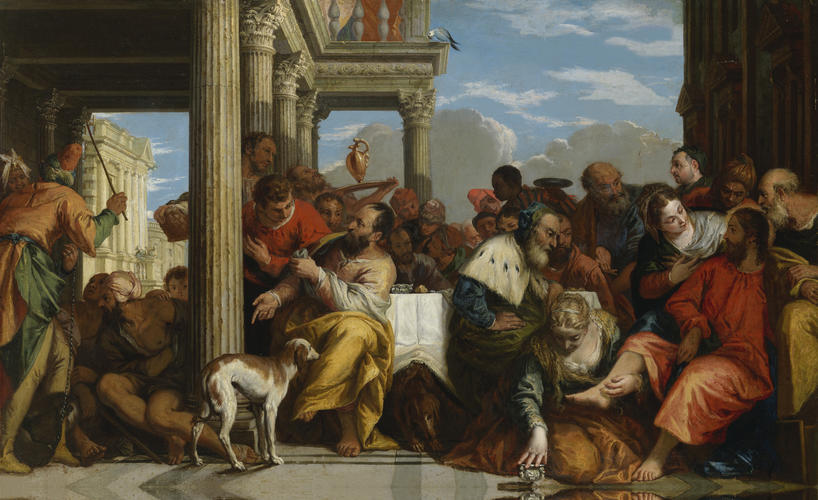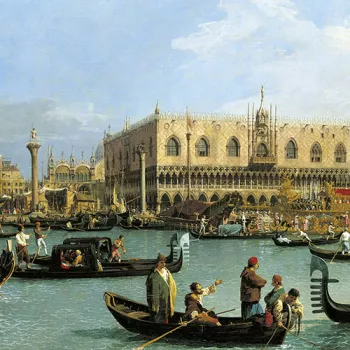The Feast in the House of Simon c.1716-18
Oil on canvas | 53.0 x 86.6 x 2 cm (support, canvas/panel/stretcher external) | RCIN 404767
-
This painting is a reduced-scale copy of Veronese's Feast in the House of Simon of 1556, made for the Benedictine monastery of Santi Nazaro and Celso in Verona, now in the Galleria Sabauda, Turin. Veronese conflates two accounts of the anointing of Christ's feet in the Gospels of St Luke and St John: in the former it is Mary Magdalene who tends to Christ in the house of Simon the Pharisee, while in the latter it is the sisters of Lazarus, Mary and Martha, who serve while Judas Iscariot protests at such extravagance. All these figures appear in the painting. Christ is seated at the far right of the composition conversing with Martha, with the Magdalen kneeling at his feet and reaching out with her right hand for the pot of ointment. The seated man on the left with the yellow mantle, with his back to Christ, must be Judas. The figure in profile behind Martha is likely to be Mauro Vecelli, the prior responsible for commissioning Veronese's painting.
Sebastiano accurately copied not only the faces and details such as Mary's plump hand resting on her elaborately decorated jar of ointment, but also most of the colours. Although prints after Veronese were in circulation, he must have either seen the original on one of his journeys across Northern Europe or had access to a very good painted copy.
He did make a few changes, however. The top part of Veronese's composition, with the figures on the loggia has been omitted. Sebastiano made the balustrade squatter, to fit into his new format, and omitted the hand of the Pharisee pointing to the scene below. It was always assumed that he deliberately omitted the gold ewer on the salver held up by the servant in the centre of the composition, as well as some of the background figures. However, cleaning and conservation of the painting for Canaletto & the Art of Venice revealed several layers of overpaint, suggesting reworkings from probably the artist and certainly a later hand. What is underneath has been revealed to be in glowing colours, carefully and thinly painted in silvery, cooler tones.
His most significant change was to Mary's pose, looking down rather than up at Christ. Changes in the paint layers to her upper torso and head and an X-radiograph prove that Sebastiano originally replicated her upward gaze in Veronese's original. The idea that Sebastiano and Smith wanted to pass off his paintings as the work of Veronese has been discussed. If this is the case, it is surprising that the figure of Mary was altered. She is the pivotal figure in the composition: by altering her pose, Sebastiano put his own stamp on his otherwise faithful copy.
The painting remains a masterful record of the Renaissance original, energised by Sebastiano's eighteenth-century style.
Adapted from Canaletto & the Art of Venice, London, 2017.Provenance
Acquired in 1762 by George III from Joseph Smith, British Consul in Venice (Italian List no 42); recorded in the Coffee Room at Kew in 1805 (no 15)
-
Creator(s)
Acquirer(s)
-
Medium and techniques
Oil on canvas
Measurements
53.0 x 86.6 x 2 cm (support, canvas/panel/stretcher external)
64.2 x 97.7 x 4.0 cm (frame, external)
Category
Object type(s)
Other number(s)
Alternative title(s)
The Magdalen Anointing Christ's Feet
Christ in the House of Simon
Christ and the Woman with the box of Ointment










